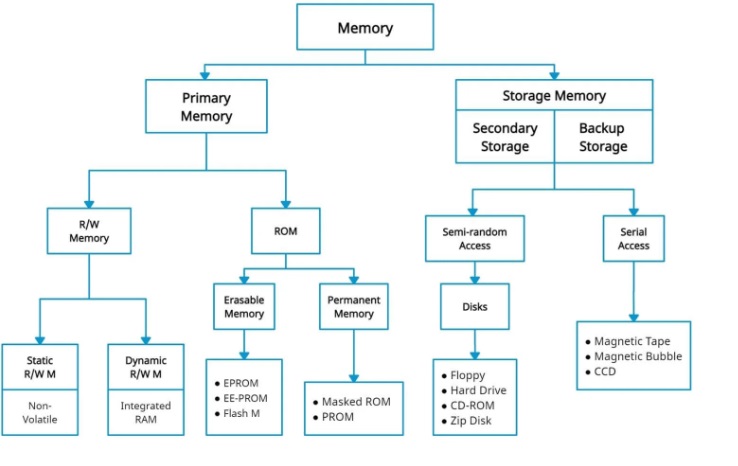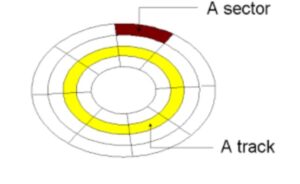What is Computer Memory?
Computer memory is just like the human brain. It is used to store data/information and instructions. It is a data storage unit or a data storage device where data is to be processed and instructions required for processing are stored. It can store both the input and output can be stored here.
Characteristics of Computer Memory
- It is faster computer memory as compared to secondary memory.
- It is semiconductor memories.
- It is usually a volatile memory, and main memory of the computer.
- A computer system cannot run without primary memory.
Types of Computer Memory
In general, computer memory is of three types:
- Primary memory
- Secondary memory
- Cache memory

1. Primary Memory
It is also known as the main memory of the computer system. It is used to store data and programs or instructions during computer operations. It uses semiconductor technology and hence is commonly called semiconductor memory. Primary memory is of two types:
RAM (Random Access Memory):
It is a volatile memory. Volatile memory stores information based on the power supply. If the power supply fails/ interrupted/stopped, all the data and information on this memory will be lost. RAM is used for booting up or start the computer. It temporarily stores programs/data which has to be executed by the processor. RAM is of two types:
S RAM (Static RAM):
S RAM uses transistors and the circuits of this memory are capable of retaining their state as long as the power is applied. This memory consists of the number of flip flops with each flip flop storing 1 bit. It has less access time and hence, it is faster.
D RAM (Dynamic RAM):
D RAM uses capacitors and transistors and stores the data as a charge on the capacitors. They contain thousands of memory cells. It needs refreshing of charge on capacitor after a few milliseconds. This memory is slower than S RAM.
ROM (Read Only Memory):
It is a non-volatile memory. Non-volatile memory stores information even when there is a power supply failed/ interrupted/stopped. ROM is used to store information that is used to operate the system. As its name refers to read-only memory, we can only read the programs and data that is stored on it. It contains some electronic fuses that can be programmed for a piece of specific information. The information stored in the ROM in binary format. It is also known as permanent memory. ROM is of four types:
MROM(Masked ROM):
Hard-wired devices with a pre-programmed collection of data or instructions were the first ROMs. Masked ROMs are a type of low-cost ROM that works in this way.
PROM (Programmable Read Only Memory): This read-only memory is modifiable once by the user. The user purchases a blank PROM and uses a PROM program to put the required contents into the PROM. Its content can’t be erased once written.
EPROM (Erasable Programmable Read Only Memory): EPROM is an extension to PROM where you can erase the content of ROM by exposing it to Ultraviolet rays for nearly 40 minutes.
EEPROM (Electrically Erasable Programmable Read Only Memory): Here the written contents can be erased electrically. You can delete and reprogramme EEPROM up to 10,000 times. Erasing and programming take very little time, i.e., nearly 4 -10 ms(milliseconds). Any area in an EEPROM can be wiped and programmed selectively.
2. Secondary Memory
It is also known as auxiliary memory and backup memory. It is a non-volatile memory and used to store a large amount of data or information. The data or information stored in secondary memory is permanent, and it is slower than primary memory. A CPU cannot access secondary memory directly. The data/information from the auxiliary memory is first transferred to the main memory, and then the CPU can access it.
Characteristics of Secondary Memory
- It is a slow memory but reusable.
- It is a reliable and non-volatile memory.
- It is cheaper than primary memory.
- The storage capacity of secondary memory is large.
- A computer system can run without secondary memory.
- In secondary memory, data is stored permanently even when the power is off.
Types of Secondary Memory
1. Magnetic Tapes: Magnetic tape is a long, narrow strip of plastic film with a thin, magnetic coating on it that is used for magnetic recording. Bits are recorded on tape as magnetic patches called RECORDS that run along many tracks. Typically, 7 or 9 bits are recorded concurrently. Each track has one read/write head, which allows data to be recorded and read as a sequence of characters. It can be stopped, started moving forward or backward, or rewound.
2. Magnetic Disks: A magnetic disk is a circular metal or a plastic plate and these plates are coated with magnetic material. The disc is used on both sides. Bits are stored in magnetized surfaces in locations called tracks that run in concentric rings. Sectors are typically used to break tracks into pieces.

Hard discs are discs that are permanently attached and cannot be removed by a single user.
3. Optical Disks: It’s a laser-based storage medium that can be written to and read. It is reasonably priced and has a long lifespan. The optical disc can be taken out of the computer by occasional users.
Types of Optical Disks
CD – ROM
It’s called compact disk. Only read from memory.
Information is written to the disc by using a controlled laser beam to burn pits on the disc surface.
It has a highly reflecting surface, which is usually aluminium.
The diameter of the disc is 5.25 inches.
16000 tracks per inch is the track density.
The capacity of a CD-ROM is 600 MB, with each sector storing 2048 bytes of data.
The data transfer rate is about 4800KB/sec. & the new access time is around 80 milliseconds.
WORM-(WRITE ONCE READ MANY)
A user can only write data once.
The information is written on the disc using a laser beam.
It is possible to read the written data as many times as desired.
They keep lasting records of information but access time is high.
It is possible to rewrite updated or new data to another part of the disc.
Data that has already been written cannot be changed.
Usual size – 5.25 inch or 3.5 inch diameter.
The usual capacity of 5.25 inch disk is 650 MB,5.2GB etc.
DVDs
The term “DVD” stands for “Digital Versatile/Video Disc,” and there are two sorts of DVDs:
DVDR (writable)
DVDRW (Re-Writable)
DVD-ROMS (Digital Versatile Discs): These are read-only memory (ROM) discs that can be used in a variety of ways. When compared to CD-ROMs, they can store a lot more data. It has a thick polycarbonate plastic layer that serves as a foundation for the other layers. It’s an optical memory that can read and write data.
DVD-R: DVD-R is a writable optical disc that can be used just once. It’s a DVD that can be recorded. It’s a lot like WORM. DVD-ROMs have capacities ranging from 4.7 to 17 GB. The capacity of 3.5 inch disk is 1.3 GB.
3. Cache Memory
It is a type of high-speed semiconductor memory that can help the CPU run faster. Between the CPU and the main memory, it serves as a buffer. It is used to store the data and programs that the CPU uses the most frequently.
Advantages of Cache Memory
It is faster than the main memory.
When compared to the main memory, it takes less time to access it.
It keeps the programs that can be run in a short amount of time.
It stores data in temporary use.
Disadvantages of Cache Memory
Because of the semiconductors used, it is very expensive.
The size of the cache (amount of data it can store) is usually small.
WRITE A NOTE ON MAGNETIC TAPE
Sequentially access storage device.
Most popular storage medium for storage large data.
Its plastic ribbon which is ½ or ¼ inch wide and 50 to 2400 feet long.
It is coated with a magnetisable recording material.
In a magnetic tape data are recorded serially.
Information is recorded on the tape in the form of tiny invisible magnetized and
non magnetized spots.
The tape ribbon is itself stored in reels or small cassette
SHORT NOTE: FLOPPY DISK
Floppy disks were introduced by IBM in 1972.
TRACK42
Prepared By: Meghna Bhatt
A floppy disk is a round, flat piece of flexible plastic which is coated with
magnetic oxide.
It is encased in square plastic cover that gives protection to the disk.
They are also referred as diskettes.
The data is read and write in floppy disk is using a device called FLOPPY DISC
DRIVE.
The long lit is provided for the read / writes head to access the disk.
The floppy disks are available in two sizes.
5 ¼ inch (1.2 MB)
3 ½ inch (1.44 MB)
WRITE A DETAIL NOTE ON HARD DISK
Hard disks are most popular secondary storage device.
It supports the direct access of the data.
It’s a thin magnetic plate which is made of metal n both side coated with
magnetic material.
The disk is divided in many tracks & the data is store in both side of the disk.
The disk pack consists of multiple disk plates.
The disk drive pack has a separate read/write head for each disk surface.
The disk drive consists of motor to rotate the disk pack about its axis at a speed
of about 5400 revolution per minute
SHORT NOTE : CD-ROM
CD-ROM (Compact Disk – Read Only Memory) is a non-erasable backing store
which can hold large amounts of data.
It’s a shiny silver colour metal disk of 5 ¼ inch and the storage capacity about 650 megabytes.
Large volume production is achieved by automated processes similar to that of
audio compact disks.
Many of today’s micro-computers come with CD-ROM readers and as a result,
CD-ROM is popularly used for distribution of software, digitized graphic images
as well as Multi-Media material.
EXPLAIN IN BRIEF: DVD
DVD (Digital Versatile Disk) is optical disk storage.
Basically it is used for storing large amount of data including movies with high
video & sound quality.
Work on the same principle of CDROM.
Data is recorded on each layer so that the storage capacity is become large.
Total capacity of DVD is 8.5 GB
EXPLAIN IN BRIEF: ZIP DISK
It’s a high capacity, removable magnetic disk which can be read or write by ZIP
drive.
It is similar to floppy disk except that much faster & larger capacity.
Zip disks are available in two size namely 100 megabytes & 250 megabytes.
SHORT NOTE: PEN DRIVE
It consists of a small printed circuit board encased in a robust plastic or metal
casing.
It is easy to carry in pocket.
It uses standard-A type connection which allows it to directly connect with the
computer.
SHORT NOTE: BLUE RAY DISK
Blue-Ray disk is an optical disc storage media format.
It was developed by blue-ray disc associations.
It is mainly used to store high definition video and data.
It has same dimensions as CD or DVD.
The violet coloured laser is used to read and write the data.
Because of its shorter wavelength more data can be stored than DVD format.
Its storage capacity is 50 GB.
